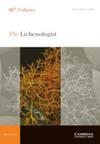北美洲西部地衣的一个新名称,被称为L.cookii,其类型对应于L.saterninumstr。
IF 1.4
4区 生物学
Q4 MYCOLOGY
引用次数: 2
摘要
作为北美Leptogium saterninum类群修订的一部分,我们将L.cookii D.F.Stone&Lendemer描述为来自美国西部和加拿大的一个新种(Stone等人,2016)。库克氏乳杆菌与该组其他成员的分离是基于形态学差异(isidium形态学、髓质解剖和铊颜色)的结合,并得到分子系统发育分析的支持。不幸的是,在原论中,我们选择了一个尚未测序的标本作为模式,Matthias Schultz和Bruce McCune随后的研究已经证明该标本与L.saterninum(Dicks.)Nyl是同种的。s.str.从L.cookii的正模上的不同位置产生了两个新的ITS序列(GenBank OK584472,OK584473),并且从先前被鉴定为L.cookiii的另一个标本产生了一个新的ITS序列(GenBank OK584474)。我们将新生成的ITS序列插入Stone等人发表的比对中。(2016)并使用该出版物中概述的最大似然方法对其进行重新分析。来自L.cookii正模的两个序列与L.saterninumstr.的所有其他参考序列一起在一个支持良好的分支(ML:86)中回收(图1)。这一结果与库克乳杆菌正模的形态学评估一致,库克乳杆菌与其他原始材料在形态上的不同之处在于,其isidium形状、髓质解剖和铊颜色。这些特征与Stone等人(2016)之后对L.saterninum s.str.的当前划界一致。从形态上与库克氏乳杆菌其他已测序标本一致的材料中新生成的序列是在一个与该分类单元的其他参考序列有强烈支持的分支(ML:100)中回收的。根据以上信息,库克乳杆菌的正模与沙氏乳杆菌(L.saterninumstr.)相对应,前者的名称必须被视为后者的异型异名。结果是,以前被称为L.cookii的分类单元现在缺乏一个有效公布的名称。在这里,我们引入了L.stancookii这个名称,以适应之前提到的L.cookii的材料,它与Stone等人(2016)对该分类单元的划界一致,但与正模型相冲突。重要的是,我们选择了一个已测序的标本作为正模标本,并确认它与源自库克乳杆菌标本的其他序列属于同一个强烈支持的分支。几种形态特征将这两个物种区分开来。在L.stancookii和L.saterninum中,isidia以围绕少量蓝藻细胞的几束短真菌菌丝细胞的形式启动,突破上部皮层并破坏皮层。在L.saterninum中,这些isidia保持颗粒状,而在L.stancookii中,它们变得不均匀的圆柱形,并且经常分枝。这不同于L.compactum D.F.Stone&Lendemer和L.hirsutum Sierk中isidia的形成,在那里,蓝藻细胞向上推进到一个小乳头中,随着乳头的扩大,皮层以连续的层扩张。斯坦库克乳杆菌的铊为浅蓝灰色,随着年龄的增长而变为褐色,而土星乳杆菌为中等至深褐灰色至黑色,幼时缺乏蓝灰色。在皮层下开始形成isidia的铊边缘附近,L.stancookii有一个均匀变黑的表面,而L.saterninum在棕色表面上有一组成角度的深色斑点。最后,两个物种的髓质解剖结构不同。在L.stancookii中,髓质由菌丝组成,这些菌丝成角度但不垂直或平行于皮层,而在L.saterninum中,许多菌丝平行或垂直于皮层。本文章由计算机程序翻译,如有差异,请以英文原文为准。
Leptogium stancookii, a new name for the western North American lichen referred to as L. cookii whose type corresponds to L. saturninum s. str.
As part of a revision of the Leptogium saturninum group in North America, we described L. cookii D. F. Stone & Lendemer as a new species from the western United States and Canada (Stone et al. 2016). The separation of L. cookii from other members of the group was based on a combination of morphological differences (isidium morphology, medulla anatomy and thallus colour) with support from molecular phylogenetic analyses. Unfortunately, in the protologue we selected as type a specimen that had not been sequenced and which subsequent study by Matthias Schultz and Bruce McCune has demonstrated is conspecific with L. saturninum (Dicks.) Nyl. s. str. Two new ITS sequences were generated from different locations on the holotype of L. cookii (GenBank OK584472, OK584473), and a new ITS sequence was generated from an additional specimen that had previously been identified as L. cookii (GenBank OK584474). We inserted the newly generated ITS sequences into the alignment published by Stone et al. (2016) and reanalyzed it with the same maximum likelihood methods as were outlined in that publication. The two sequences from the holotype of L. cookii were recovered in a well-supported clade (ML: 86) with all other reference sequences of L. saturninum s. str. (Fig. 1). This result agrees with the morphological assessment of the holotype of L. cookii, which differs from the other original material morphologically in isidium shape, medulla anatomy and thallus colour. These characters instead agree with the current delimitation of L. saturninum s. str. following Stone et al. (2016). The newly generated sequence from material that agrees morphologically with the other sequenced specimens of L. cookii was recovered in a strongly supported clade (ML: 100) with the other reference sequences of that taxon. Based on the above information, the holotype of L. cookii corresponds to L. saturninum s. str. and the former name must be treated as a heterotypic synonym of the latter. The result is that the taxon previously referred to as L. cookii now lacks a validly published name. Here we introduce the name L. stancookii to accommodate the material previously referred to L. cookii and which agrees with the delimitation of that taxon by Stone et al. (2016) but is in conflict with the holotype. Importantly, we select a sequenced specimen as holotype and confirm that it belongs to the same strongly supported clade as other sequences derived from specimens of L. cookii. Several morphological characters distinguish the two species. In both L. stancookii and L. saturninum, isidia initiate as bundles of several short fungal hyphal cells surrounding a small number of cyanobacterial cells, breaking through the upper cortex and disrupting the cortex. In L. saturninum, these isidia remain granular, while in L. stancookii they become unevenly cylindrical and often branched. This differs from isidia formation in L. compactum D. F. Stone & Lendemer and L. hirsutum Sierk, where cyanobacterial cells push upwards into a tiny papilla and the cortex expands in a continuous layer as the papilla enlarges. The thallus in L. stancookii is pale blue-grey, becoming brownish with age, while L. saturninum is medium to dark brown-grey to blackish, lacking the blue-grey colour when young. Near the thallus margins where isidia are beginning to form beneath the cortex, L. stancookii has an evenly blackened surface while L. saturninum has a pattern of dark speckles in angular groups on a brown surface. Finally, the anatomy of the medulla differs between the two species. In L. stancookii the medulla is made of hyphae that are angled but not perpendicular or parallel to the cortices, while in L. saturninum many hyphae are parallel or perpendicular to the cortices.
求助全文
通过发布文献求助,成功后即可免费获取论文全文。
去求助
来源期刊

Lichenologist
生物-真菌学
CiteScore
2.90
自引率
14.30%
发文量
23
审稿时长
6.0 months
期刊介绍:
The Lichenologist is the premier scientific journal devoted exclusively to the study of lichens worldwide. As the leading forum for the dissemination of new concepts and topical reviews, The Lichenologist reaches more scientists concerned with the study of lichens and lichen symbionts than any other single journal. All aspects of lichenology are considered including systematics and phylogenetics; molecular biology; ultrastructure, anatomy and morphology; secondary chemistry, effects of pollutants and use as bioindicators; biogeography. In addition to standard length research papers, the journal also publishes Short Communications and Book Reviews. A monthly issue may occasionally be devoted to papers deriving from a symposium.
 求助内容:
求助内容: 应助结果提醒方式:
应助结果提醒方式:


